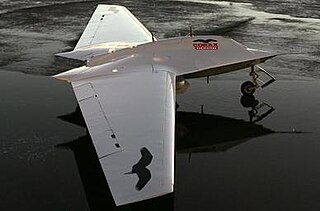Related Research Articles

A raven is one of several larger-bodied species of the genus Corvus. These species do not form a single taxonomic group within the genus.
Medieval metal is a subgenre of folk metal that blends heavy metal music with medieval folk music. Medieval metal is mostly restricted to Germany where it is known as Mittelalter-Metal or Mittelalter-Rock. The genre emerged from the middle of the 1990s with contributions from Subway to Sally, In Extremo and Schandmaul. The style is characterised by the prominent use of a wide variety of traditional folk and medieval instruments.

The common raven, also known as the western raven or northern raven when discussing the raven at the subspecies level, is a large all-black passerine bird. Found across the Northern Hemisphere, it is the most widely distributed of all corvids. There are at least eight subspecies with little variation in appearance, although recent research has demonstrated significant genetic differences among populations from various regions. It is one of the two largest corvids, alongside the thick-billed raven, and is possibly the heaviest passerine bird; at maturity, the common raven averages 63 centimetres in length and 1.2 kilograms in mass. Although their typical lifespan is considerably shorter, common ravens can live more than 23 years in the wild, which among passerines only is surpassed by a few Australian species such as the satin bowerbird and probably the lyrebirds. Young birds may travel in flocks but later mate for life, with each mated pair defending a territory.
Corax was one of the founders of ancient Greek rhetoric. Some scholars contend that both founders are merely legendary personages, others that Corax and Tisias were the same person, described in one fragment as "Tisias, the Crow". And according to Aristotle, Empedocles was the actual founder of rhetoric, but this is also unlikely. It is believed that William Shakespeare derived the name Sycorax from Corax of Syracuse. Corax is said to have lived in Sicily in the 5th century BC, when Thrasybulus, tyrant of Syracuse, was overthrown and a democracy formed.

Corvus Corax is a German band known for playing neo-Medieval music using authentic instruments. Their name is the Latin name for the common raven. The band was formed in 1989 by Castus Rabensang, Wim (Venustus) and Meister Selbfried in East Germany. The band often uses bagpipes as the solo instrument; their live performances attract attention with the bizarre look of the musicians being reminiscent of ancient Greek myths: half-naked, dressed in unusual clothes, wearing primitive tribal decorations, often tattooed.

The Corax, also known as Raven, is a prototype unmanned aerial vehicle (UAV) for the British Armed Forces being developed by BAE Systems Military Air & Information.
Neo-Medieval music is a modern popular music characterized by elements of Medieval music and early music in general. Music styles within neo-Medieval music vary from authentic performance interpretations of Medieval music to crossover genres that blend Medieval instruments, such as bagpipe, shawm and hurdy-gurdy with electronic music and rock. In many cases, it is more or less overlapping with styles such as folk rock, British folk rock and neofolk.
Tisias, along with Corax of Syracuse, was one of the founders of ancient Greek rhetoric. Tisias was reputed to have been the pupil of the lawyer Corax, who agreed to teach Tisias under the condition that he would give him payment for schooling if he won his first case. If on the other hand, he did not win his first case he would not have to pay the fee because the instruction was useless. Tisias is said to have developed legal rhetoric upon the foundations laid by Corax's pioneering work in the field of philosophical argument. He is also believed to have been the teacher of Isocrates. It has sometimes been asserted that Tisias and Corax are merely legendary personages. Other scholars contend that Corax and Tisias were the same person. All we know of the work of Tisias is from references made by later writers, such as Plato, Aristotle, and Cicero.
Chrysocale ferens is a moth of the subfamily Arctiinae. It was described by Schaus in 1896. It is found in Bolivia and Peru.
Chrysocale fletcheri is a moth of the subfamily Arctiinae. It was described by Viette in 1980. It is found in Peru.
Chrysocale gigantea is a moth of the subfamily Arctiinae. It was described by Herbert Druce in 1890. It is found in Colombia and Bolivia.
Chrysocale gigas is a moth of the subfamily Arctiinae. It was described by Rothschild in 1911. It is found in Colombia, Ecuador and Peru.

Chrysocale ignita is a moth of the subfamily Arctiinae. It was described by Gottlieb August Wilhelm Herrich-Schäffer in 1853. It is found in Colombia.
Chrysocale pava is a moth in the subfamily Arctiinae. It was described by Paul Dognin in 1893. It is found in Venezuela.

Chrysocale principalis, the princely tiger moth, is a moth of the subfamily Arctiinae. It was described by Francis Walker in 1864. It is found in Mexico and Guatemala.
Chrysocale regalis is a moth of the subfamily Arctiinae. It was described by Jean Baptiste Boisduval in 1836. It is found in Ecuador and Bolivia.
Chrysocale splendens is a moth of the subfamily Arctiinae. It was described by Paul Dognin in 1888. It is found in Ecuador.
Chrysocale uniformis is a moth of the subfamily Arctiinae. It was described by Max Wilhelm Karl Draudt in 1917.
The Euchromiina are a subtribe of tiger moths in the family Erebidae. It was described by Arthur Gardiner Butler in 1876. Many species in the subtribe are mimics of wasps.
References
- ↑ Beccaloni, G.; Scoble, M.; Kitching, I.; Simonsen, T.; Robinson, G.; Pitkin, B.; Hine, A.; Lyal, C., eds. (2003). "Chrysocale corax". The Global Lepidoptera Names Index . Natural History Museum . Retrieved April 30, 2018.
| This Euchromiina-related article is a stub. You can help Wikipedia by expanding it. |